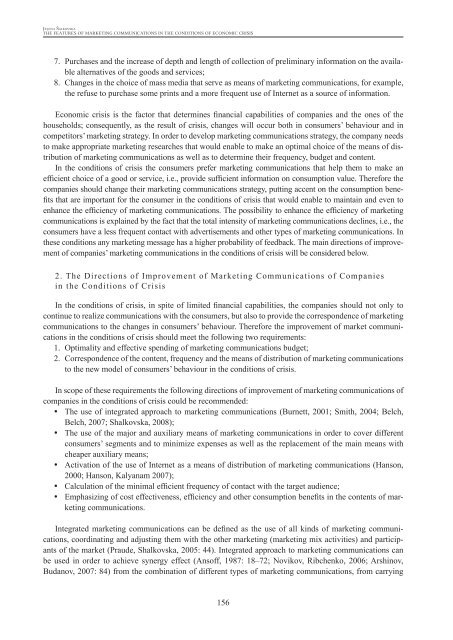regional formation and development studies - KlaipÄdos universitetas
regional formation and development studies - KlaipÄdos universitetas
regional formation and development studies - KlaipÄdos universitetas
You also want an ePaper? Increase the reach of your titles
YUMPU automatically turns print PDFs into web optimized ePapers that Google loves.
Jeļena Šalkovska<br />
THE FEATURES OF MARKETING COMMUNICATIONS IN THE CONDITIONS OF ECONOMIC CRISIS<br />
7. Purchases <strong>and</strong> the increase of depth <strong>and</strong> length of collection of preliminary in<strong>formation</strong> on the available<br />
alternatives of the goods <strong>and</strong> services;<br />
8. Changes in the choice of mass media that serve as means of marketing communications, for example,<br />
the refuse to purchase some prints <strong>and</strong> a more frequent use of Internet as a source of in<strong>formation</strong>.<br />
Economic crisis is the factor that determines financial capabilities of companies <strong>and</strong> the ones of the<br />
households; consequently, as the result of crisis, changes will occur both in consumers’ behaviour <strong>and</strong> in<br />
competitors’ marketing strategy. In order to develop marketing communications strategy, the company needs<br />
to make appropriate marketing researches that would enable to make an optimal choice of the means of distribution<br />
of marketing communications as well as to determine their frequency, budget <strong>and</strong> content.<br />
In the conditions of crisis the consumers prefer marketing communications that help them to make an<br />
efficient choice of a good or service, i.e., provide sufficient in<strong>formation</strong> on consumption value. Therefore the<br />
companies should change their marketing communications strategy, putting accent on the consumption benefits<br />
that are important for the consumer in the conditions of crisis that would enable to maintain <strong>and</strong> even to<br />
enhance the efficiency of marketing communications. The possibility to enhance the efficiency of marketing<br />
communications is explained by the fact that the total intensity of marketing communications declines, i.e., the<br />
consumers have a less frequent contact with advertisements <strong>and</strong> other types of marketing communications. In<br />
these conditions any marketing message has a higher probability of feedback. The main directions of improvement<br />
of companies’ marketing communications in the conditions of crisis will be considered below.<br />
2. The Directions of Improvement of Marketing Communications of Companies<br />
in the Conditions of Crisis<br />
In the conditions of crisis, in spite of limited financial capabilities, the companies should not only to<br />
continue to realize communications with the consumers, but also to provide the correspondence of marketing<br />
communications to the changes in consumers’ behaviour. Therefore the improvement of market communications<br />
in the conditions of crisis should meet the following two requirements:<br />
1. Optimality <strong>and</strong> effective spending of marketing communications budget;<br />
2. Correspondence of the content, frequency <strong>and</strong> the means of distribution of marketing communications<br />
to the new model of consumers’ behaviour in the conditions of crisis.<br />
In scope of these requirements the following directions of improvement of marketing communications of<br />
companies in the conditions of crisis could be recommended:<br />
• y The use of integrated approach to marketing communications (Burnett, 2001; Smith, 2004; Belch,<br />
Belch, 2007; Shalkovska, 2008);<br />
• y The use of the major <strong>and</strong> auxiliary means of marketing communications in order to cover different<br />
consumers’ segments <strong>and</strong> to minimize expenses as well as the replacement of the main means with<br />
cheaper auxiliary means;<br />
• y Activation of the use of Internet as a means of distribution of marketing communications (Hanson,<br />
2000; Hanson, Kalyanam 2007);<br />
• y Calculation of the minimal efficient frequency of contact with the target audience;<br />
• y Emphasizing of cost effectiveness, efficiency <strong>and</strong> other consumption benefits in the contents of marketing<br />
communications.<br />
Integrated marketing communications can be defined as the use of all kinds of marketing communications,<br />
coordinating <strong>and</strong> adjusting them with the other marketing (marketing mix activities) <strong>and</strong> participants<br />
of the market (Praude, Shalkovska, 2005: 44). Integrated approach to marketing communications can<br />
be used in order to achieve synergy effect (Ansoff, 1987: 18–72; Novikov, Ribchenko, 2006; Arshinov,<br />
Budanov, 2007: 84) from the combination of different types of marketing communications, from carrying<br />
156

















